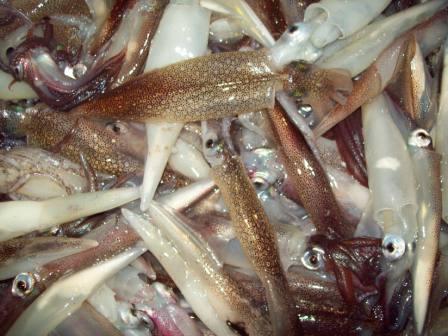I was fascinated by hypodermic insemination when I first learned about it as an undergraduate. I wrote my final paper for a class called Sex and Evolution on the topic of coerced mating, focusing primarily on hypodermic insemination (with a brief aside about ducks). This type of mating is by no means unique to squid--it's been found in disparate creatures from rotifers to flatworms--but of course I think squid are the most interesting. For years, I've bent the ear of anyone who would listen with tales of this bizarre phenomenon, without ever really understanding how it worked.
In reading Marian's paper, I was delighted to learn that no one else understands it either. As I mentioned before, only some species of squid use hypodermic insemination, and unfortunately these species tend to be rare and/or difficult to find. But through one of those beautiful accidents that often drive scientific discovery, Marian may have hit upon an easier way to study it.
He and his colleagues were working with the loliginid squid Doryteuthis plei, which, like all other loliginids, uses cement glands to effect adhesive attachment of spermatophores. In natural mating, the male uses one of his arms to place his spermatophores on the female's skin. The researchers were simulating this type of mating in vitro by using tweezers to apply spermatophores to small pieces of squid skin under a microscope.
"By a mistake of the present author," as Marian so graciously phrases it, a spermatophore was aimed toward the cut muscle underneath the skin instead of toward the skin itself. Instead of sticking to the muscle with its cement gland, as it would have stuck to the skin, the spermatophore executed a surprise attack, penetrating and embedding itself deep in the flesh. The phenemenon could be reliably repeated, and appeared strikingly similar to the hypodermic insemination described in other species of squid.
Hypodermic insemination has never been seen in loliginids, and Marian supposes his observations to be an artefact of the in vitro technique, rather than being indicative of anything that would happen naturally.
But that doesn't matter. If in vitro hypodermic insemination in loliginids is similar enough to natural hypodermic insemination in deep-sea squids, then the former could be used as a model system to study the latter. Loliginid squid are much easier to acquire than any of the squid species that are known to engage in hypodermic insemination.

Loliginid squid are very easy to catch.

Natural hypodermic inseminators like giant squid are a lot more work.
And that might help us figure out the mechanics of how exactly hypodermic insemination happens in squid. I've often heard (and quoted) the theory that the penis itself acts as a sort of hydraulic syringe, using water pressure to drive spermatophores into the female's skin. Another theory is that the male squid could use his beak to make an incision, then drop the spermatophores in. (Is rubbing sperm in the wound as bad as rubbing salt?) But neither theory has been supported with observations, as far as I know.
Marian's results with loliginid spermatophores suggest that neither penis nor beak may be necessary--the spermatophore itself could act as both syringe and payload. The details await discovey, and I can't wait to read the next paper!




Comments